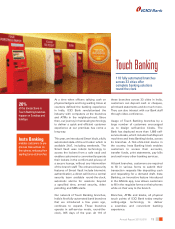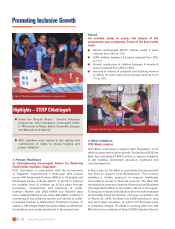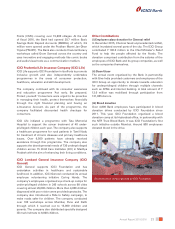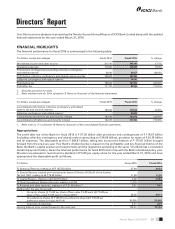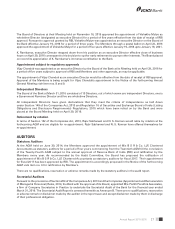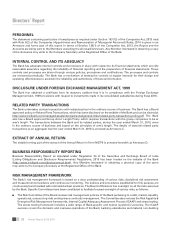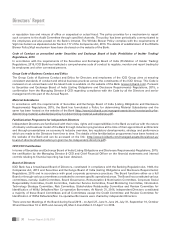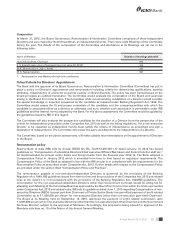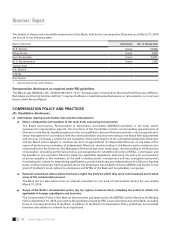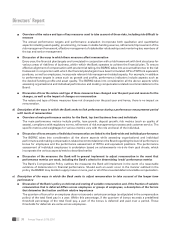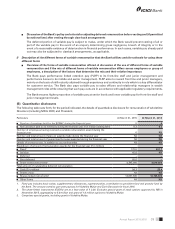ICICI Bank 2016 Annual Report Download - page 31
Download and view the complete annual report
Please find page 31 of the 2016 ICICI Bank annual report below. You can navigate through the pages in the report by either clicking on the pages listed below, or by using the keyword search tool below to find specific information within the annual report.
29Annual Report 2015-2016
subsidiaries. The Committee reviews migration to the advanced approaches under Basel II and implementation of
Basel III, risk return prole of the Bank, compliance with RBI guidelines pertaining to credit, market and operational
risk management systems and the activities of the Asset Liability Management Committee. The Committee reviews
the level and direction of major risks pertaining to credit, market, liquidity, operational, technology, compliance,
group, management and capital at risk as part of risk dashboard. In addition, the Committee has oversight on risks of
subsidiaries covered under the Group Risk Management Framework. The Risk Committee also reviews the Liquidity
Contingency Plan for the Bank and the threshold limits.
The Credit Committee of the Board, apart from sanctioning credit proposals based on the Bank’s credit authorisation
framework, reviews developments in key industrial sectors and the Bank’s exposure to these sectors as well as to
large borrower accounts and borrower groups. The Credit Committee also reviews the major credit portfolios, non-
performing loans, accounts under watch, overdues and incremental sanctions.
The Audit Committee of the Board provides direction to and monitors the quality of the internal audit function and also
monitors compliance with inspection and audit reports of Reserve Bank of India, other regulators and statutory auditors.
The Asset Liability Management Committee is responsible for managing liquidity and interest rate risk and reviewing
the asset-liability position of the Bank.
Summaries of reviews conducted by these Committees are reported to the Board on a regular basis.
Policies approved from time to time by the Board of Directors/Committees of the Board form the governing framework
for each type of risk. The business activities are undertaken within this policy framework. Independent groups and sub-
groups have been constituted across the Bank to facilitate independent evaluation, monitoring and reporting of various
risks. These groups function independently of the business groups/sub-groups.
The Bank has dedicated groups, namely, the Risk Management Group, Compliance Group, Corporate Legal Group,
Internal Audit Group and the Financial Crime Prevention & Reputation Risk Management Group, with a mandate to
identify, assess and monitor all of the Bank’s principal risks in accordance with well-dened policies and procedures.
The Risk Management Group is further organised into the Credit Risk Management Group, Market Risk Management
Group and Operational Risk Management Group. These groups are completely independent of all business operations
and coordinate with representatives of the business units to implement the Bank’s risk management policies and
methodologies. The Internal Audit and Compliance groups are responsible to the Audit Committee of the Board.
INFORMATION REQUIRED UNDER SEXUAL HARASSMENT OF WOMEN AT WORKPLACE
(PREVENTION, PROHIBITION & REDRESSAL) ACT, 2013
Please refer Principle 3 under Section E of the Business Responsibility Report.
CORPORATE GOVERNANCE
The corporate governance framework at ICICI Bank is based on an effective independent Board, the separation of the
Board’s supervisory role from the executive management and the constitution of Board Committees, which at March 31,
2016 comprised majority of independent Directors and most of the Committees were chaired by independent Directors,
to oversee critical areas.
I. Philosophy of Corporate Governance
ICICI Bank’s corporate governance philosophy encompasses regulatory and legal requirements, which aims at a high
level of business ethics, effective supervision and enhancement of value for all stakeholders. The corporate governance
framework adopted by the Bank already encompasses signicant portion of the recommendations contained in the
‘Corporate Governance Voluntary Guidelines 2009’ issued by the Ministry of Corporate Affairs, Government of India.
Whistle Blower Policy
The Bank has formulated a Whistle Blower Policy. The policy comprehensively provides an opportunity for any employee/
Director of the Bank to raise any issue concerning breaches of law, accounting policies or any act resulting in nancial


